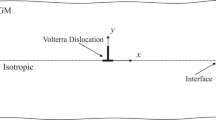Abstract
The conventional formulation used in the past for problems involving interface cracks leads to a physical contradiction: The two sides of the crack are assumed to be free of tractions in the formulation, but the crack faces are seen to overlap after the solution is constructed. This unsatisfactory feature can be eliminated by introducing contact zones at the tips of an interface crack. The present article investigates the effect of friction in the contact zones for loads that start from zero and are increased monotonically. As an application, shear loading is considered, and the problem is reduced to a singular integral equation with a Cauchy-type kernel which is solved numerically. The results show that one of the contact zones is large and that friction affects the global nature of the stress fields. The results worked out include also the stress intensity factors, crack opening displacement, and the pressure distribution in the larger contact zone.
Résumé
La formulation habituelle utilisée dans le passé pour des problèmes de fissures interfaciales conduit à une contradiction physique: Les deux lèvres de la fissure doivent être libres de contraintes, mais la solution peut impliquer une interpénétration des bords. Il est possible d'éliminer cette contradiction physique en introduisant des zones de contact aux pointes de la fissure. Le présent article étudie l'effet du frottement dans les zones de contact pour des charges croissantes à partir de zero. Comme application, on considère une charge de cisaillement et le problème se réduit à une équation intégrale singulière avec un noyau de type Cauchy. Cette équation est résolue numériquement. Les résultats montrent que l'une des zones de contact est grande et que le frottement modifie l'ensemble du champ de contraintes. On a aussi obtenu les facteurs d'intensité de contraintes, l'ouverture de la fissure et la distribution du pression dans la plus grande zone de contact.
Similar content being viewed by others
References
A. H.England, Journal of Applied Mechanics, 32 (1965) 400.
B. M.Malyshev and R. L.Salganik, International Journal of Fracture Mechanics 1 (1965) 114.
M.Comninou, Journal of Applied Mechanics, 44 (1977) 631.
M.Comninou, Journal of Applied Mechanics, 44 (1977) 780.
M.Comninou, Journal of Applied Mechanics, 45 (1978) 287.
L. E.Goodman, Journal of Applied Mechanics, 29 (1962) 515.
J. Dundurs and M. Comninou, (unpublished work).
M.Comninou, Philosophical Magazine, 36 (1977) 1281.
J.Dundurs and M.Comninou, Journal of Elasticity, 9 (1979) 71.
N. I. Muskhelishvili, Singular Integral Equations, Noordhoff (1953).
I. S. Gradshteyn and I. W. Ryzhik, Tables of Integrals, Series and Products, Academic Press (1965).
S.Krenk, Quarterly of Applied Mathematics, 33 (1975) 225.
Author information
Authors and Affiliations
Rights and permissions
About this article
Cite this article
Comninou, M., Dundurs, J. Effect of friction on the interface crack loaded in shear. J Elasticity 10, 203–212 (1980). https://doi.org/10.1007/BF00044504
Received:
Issue Date:
DOI: https://doi.org/10.1007/BF00044504




